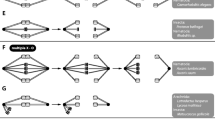Abstract
The administration of 40° C heat-treatments was found to induce bivalent orientational instability and interlocking at male meiosis in the locust Locusta migratoria. Only the longest members of the complement showed orientational instability and these usually possessed single distally sited chiasmata, with near-maximal intercentromeric distances. An effect on the stability of spindle fibre microtubule association, or attachment to the chromosome, is considered to be a possible explanation of the behaviour found. Bipolar orientation was generally achieved prior to anaphase I so that chromosome segregation was usually normal. Diamphitelic bivalents provided the most common exception to this rule. They sometimes lagged at anaphase, with the separation of half-bivalents and the production of structures indistinguishable from lagging univalents. The bivalent interlocking also involved the longest members of the complement. Most combinations of rod/rod, rod/ring and ring/ring types of interlocking were found. Usually only two bivalents were interlocked in any one cell, although occasionally three were found interlocked. All types appeared to involve an effect on the regulation of chromosome pairing, although at least one of the cells found showed interlocking caused by the metaphase orientational instability. In most cells, interlocked bivalents showed stable orientation and this usually involved the unipolar orientation of each bivalent's two centromeres. Such configurations provide concrete support for the importance of physical tension in the maintenance of metaphase orientational stability. They lead to double non-disjunction at anaphase I. Interlocked bivalents showed normal congression to a mid-equatorial position with no tendency for the re-adjustment of arm ratios to equalise centromere distances from the poles. This behaviour is discussed in relation to spindle fibre dynamics and it is concluded that no hypothesis of congression currently available can satisfactorily explain all that we know of the behaviour of univalents, bivalents, multivalents and interlocked bivalents.
Similar content being viewed by others
References
Bajer, A.: In: Chromosomes today, 3. (Proc. 3rd. Oxford Chromosome Conference 1970.) (In preparation.)
Bauer, H., Dietz, R., Röbbelen, C.: Die Spermatocytenteilungen der Tipuliden. III. Das Bewegungsverhalten der Chromosomen in Translokationsheterozygoten von Tipula oleracea. Chromosoma (Berl.) 12, 116–189 (1961).
Bernal, J. D.: Structural units in cellular physiology. Publ. Amer. Assoc. Adv. Sci. 14, 199–205 (1940).
Böök, A.: Equilibrium of trivalents at metaphase. Hereditas (Lund) 31, 499 (1945).
Buss, M. E.: Ph. D. Thesis, University of Cambridge (1971).
-Henderson, S. A.: Induced bivalent interlocking and the course of meiotic chromosome synapsis. Nature (Lond.) (in press 1971).
Callan, H. G.: The sex determining mechanism of the earwig Forficula auricularia. J. Genet. 41, 349–374 (1941).
Darlington, C. D.: Recent advances in cytology, 2nd. ed. London: Churchill, 1937.
Dietz, R.: Multiple Geschlechtschromosomen bei den cypriden Ostracoden, ihre Evolution und ihr Teilungsverhalten. Chromosoma (Berl.) 9, 359–440 (1958).
—: Bau und Funktion des Spindelapparates. Naturwissenschaften 56, 237–248 (1969).
Henderson, S. A.: Temperature and chiasma formation in Schistocerca gregaria. II. Cytological effects at 40° C and the mechanism of heat-induced univalence. Chromosoma (Berl.) 13, 437–463 (1962).
—: Sex chromosomal polymorphism in the earwig Forficula. Chromosoma (Berl.) 31, 139–164 (1970).
— Koch, C. A.: Co-orientational stability by physical tension: a demonstration with experimentally interlocked bivalents. Chromosoma (Berl.) 29, 207–216 (1970).
— Nicklas, R. B., Koch, C. A.: Temperature-induced orientation instability during meiosis: an experimental analysis. J. Cell Sci. 6, 323–350 (1970).
Hughes-Schrader, S.: Polarization, kinetochore movements and bivalent structure in the meiosis of male mantids. Biol. Bull. (Woods Hole) 85, 265–300 (1943).
—: The ‘premetaphase stretch’ and kinetochore orientation in phasmids. Chromo soma (Berl.) 3, 1–21 (1947).
—: Expulsion of the sex chromosome from the spindle in spermatocytes of a mantid. Chromosoma (Berl.) 3, 257–270 (1948).
—: The chromosomes of mantids (Orthoptera: Manteidae) in relation to taxonomy. Chromosoma (Berl.) 4, 1–55 (1950).
Inoué, S.: Organisation and function of the mitotic spindle. In: Primitive motile systems in cell biology (R. D. Allen and N. Kamiya, eds.), p. 549–594. New York: Academic Press 1964.
—, Sato, H.: Cell motility by labile association of molecules. J. gen. Physiol. 50 (Suppl.), 259–288 (1967).
Lewis, K. R., John, B.: The organisation and evolution of the sex multiple in Blaps mucronata. Chromosoma (Berl.) 9, 69–80 (1957).
Lima-de-Faria, A.: The role of the kinetochore in chromosome organisation. Hereditas (Lund) 42, 85–160 (1956).
McIntosh, J. R., Hepler, P. K., Wie, D. G. van: Model for mitosis. Nature (Lond.) 224, 659–663 (1969).
Morgan, W. P.: A comparative study of the spermatogenesis of five species of earwigs. J. Morph. 46, 241–271 (1928).
Nicklas, R. B.: Chromosome micromanipulation. II. Induced reorientation and the experimental control of segregation in meiosis. Chromosoma (Berl.) 21, 17–50 (1967).
—: Mitosis. In: Advances in cell biology, vol. II, (D M. Prescott, L. Goldstein and E. H. McConkey, eds.). New York: Appleton-Century-Crofts 1971.
—, Koch, C. A.: Chromosome micromanipulation. III. Spindle fibre tension and the reorientation of mal-orientated chromosomes. J. Cell Biol. 43, 40–50 (1969).
—, Staehly, C. A.: Chromosome micromanipulation. I. The mechanics of chromosome attachment to the spindle. Chromosoma (Berl.) 21, 1–16 (1967).
Östergren, G.: Equilibrium of trivalents and the mechanism of chromosome movements. Hereditas (Lund) 31, 498 (1945).
—: Considerations on some elementary features of mitosis. Hereditas (Lund) 36, 1–18 (1950).
—: The mechanism of co-orientation in bivalents and multivalents. The theory of orientation by pulling. Hereditas (Lund) 37, 85–156 (1951).
Rashevsky, N.: Some remarks on the movement of chromosomes during cell division. Bull. math. Biophys. 3, 1–3 (1941).
White, M. J. D.: Sex chromosomes and meiotic mechanisms in some African and Australian mantids. Chromosoma (Berl.) 16, 521–547 (1965).
Author information
Authors and Affiliations
Rights and permissions
About this article
Cite this article
Buss, M.E., Henderson, S.A. The induction of orientational instability and bivalent interlocking at meiosis. Chromosoma 35, 153–183 (1971). https://doi.org/10.1007/BF00285735
Received:
Accepted:
Issue Date:
DOI: https://doi.org/10.1007/BF00285735




